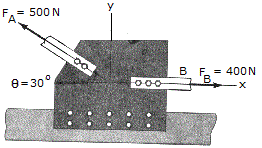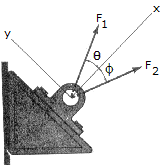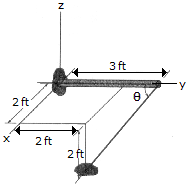Engineering Mechanics - Force Vectors
Exercise : Force Vectors - General Questions
- Force Vectors - General Questions
16.

Determine the magnitude and direction of the resultant force.
17.

The gusset plate G of a bridge joint is subjected to the two member forces at A and B. If the force at B is horizontal and the force at A is directed at  = 30°, determine the magnitude and direction of the resultant force.
= 30°, determine the magnitude and direction of the resultant force.
18.

If  = 20° and
= 20° and  = 35°, determine the magnitudes of F1 and F2 so that the resultant force has a magnitude of 20 lb and is directed along the positive x axis.
= 35°, determine the magnitudes of F1 and F2 so that the resultant force has a magnitude of 20 lb and is directed along the positive x axis.
19.

Determine the angle  between the pole AC and the wire AB.
between the pole AC and the wire AB.
20.

Two forces act on a block. Determine the angle  between them.
between them.
Quick links
Quantitative Aptitude
Verbal (English)
Reasoning
Programming
Interview
Placement Papers